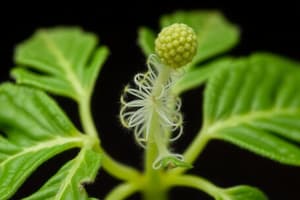Podcast
Questions and Answers
What is the cuticle?
What is the cuticle?
early plant adaptation; a waxy protective covering on plant surfaces that prevents water loss
What is a spore?
What is a spore?
haploid reproductive cell surrounded by a hard outer wall
What is a seed?
What is a seed?
embryo surrounded by a protective coat
What is endosperm?
What is endosperm?
What is vascular tissue?
What is vascular tissue?
What does xylem do?
What does xylem do?
What does phloem carry?
What does phloem carry?
What is woody tissue?
What is woody tissue?
What does herbaceous mean?
What does herbaceous mean?
What are nonvascular plants?
What are nonvascular plants?
What are vascular plants?
What are vascular plants?
What are seed plants?
What are seed plants?
What are gymnosperms?
What are gymnosperms?
What are angiosperms?
What are angiosperms?
What is a sporophyte?
What is a sporophyte?
What is a gametophyte?
What is a gametophyte?
What does alternation of generations mean?
What does alternation of generations mean?
What are Bryophytes?
What are Bryophytes?
What are rhizoids?
What are rhizoids?
What is Sphagnum?
What is Sphagnum?
What does thalloid refer to?
What does thalloid refer to?
What is a strobilus?
What is a strobilus?
What is a rhizome?
What is a rhizome?
What are fiddleheads?
What are fiddleheads?
What are fronds?
What are fronds?
What does germinate mean?
What does germinate mean?
What is a seedling?
What is a seedling?
What is a cone in botany?
What is a cone in botany?
What does deciduous mean?
What does deciduous mean?
What is ephedrine?
What is ephedrine?
What is an ovary in a flower?
What is an ovary in a flower?
What are cotyledons?
What are cotyledons?
What is a monocot?
What is a monocot?
What is a dicot?
What is a dicot?
What are veins in plants?
What are veins in plants?
What is parallel venation?
What is parallel venation?
What is net venation?
What is net venation?
Flashcards are hidden until you start studying
Study Notes
Plant Adaptations and Structures
- Cuticle: A waxy layer that covers plant surfaces to minimize water loss, crucial for survival in terrestrial environments.
- Spore: A haploid reproductive cell encased in a tough outer wall, enabling survival in harsh conditions.
- Seed: Consists of an embryo with a protective coating, allowing plants to reproduce successfully.
Plant Tissues
- Endosperm: Nutritive tissue that supports the developing plant embryo inside the seed.
- Vascular tissue: Essential for transporting water and nutrients throughout the plant, comprising two main types.
- Xylem: Responsible for transporting water and inorganic nutrients from roots to other parts of the plant in a unidirectional flow.
- Phloem: Transports organic compounds like carbohydrates and some nutrients throughout the plant, functioning bidirectionally.
Plant Types and Characteristics
- Woody tissue: Formed from multiple layers of xylem, typically found centrally in stems, contributing to structural support.
- Herbaceous plants: Soft, non-woody plants characterized by green stems.
- Nonvascular plants: Lack specialized tissues for transport, do not have true roots, stems, or leaves; examples include mosses.
- Vascular plants: Possess true roots, stems, and leaves with specialized conducting tissues for efficient nutrient and water transport.
- Seed plants: Reproduce by producing seeds, encompassing gymnosperms and angiosperms.
- Gymnosperms: Non-flowering plants that produce seeds not enclosed by fruits.
- Angiosperms: Flowering plants that produce seeds within a protective fruit.
Life Cycle and Reproductive Phases
- Sporophyte: The diploid phase of the plant life cycle that generates haploid spores for reproduction.
- Gametophyte: The haploid phase that produces gametes necessary for sexual reproduction.
- Alternation of generations: A life cycle strategy where plants alternate between sporophyte and gametophyte stages.
Nonvascular Plants
- Bryophytes: Includes three phyla of nonvascular plants, characterized by dependence on water for reproduction.
- Rhizoids: Structures anchoring gametophytes to the soil, functioning similarly to roots.
Ferns and Other Features
- Sphagnum: A type of peat moss, significant for water retention and carbon storage.
- Thalloid: A flat plant body exhibiting clear upper and lower surfaces.
- Strobilus: A reproductive structure resembling a cone, comprising sporangia-bearing modified leaves.
- Rhizome: An underground stem that serves as a storage organ and means of vegetative reproduction.
- Fiddleheads: The tightly coiled new leaves of ferns, emerging in spring.
- Fronds: Developed leaves that unfold from fiddleheads.
Germination and Seedlings
- Germinate: The process by which a seed embryo begins to develop and grow into a new plant.
- Seedling: An early developmental stage of a plant emerging from the seed.
Reproductive Structures
- Cone: A structure containing reproductive components, usually consisting of hard scales.
- Deciduous trees: Trees that shed their leaves in autumn, adapting to seasonal changes.
- Ovary: The part of the flower that encloses the ovules, protecting the developing seeds.
Cotyledons and Plant Classification
- Cotyledons: Seed leaves that provide initial nutrients to the developing plant embryo.
- Monocots: Plants characterized by a single cotyledon, typically exhibiting parallel venation.
- Dicots: Plants with two cotyledons, often displaying net venation in leaves.
- Veins: Bundles of vascular tissue that facilitate transportation within leaves.
- Parallel venation: A leaf structure where veins run parallel to each other.
- Net venation: A branching pattern of veins forming an interconnected network within leaves.
Studying That Suits You
Use AI to generate personalized quizzes and flashcards to suit your learning preferences.




